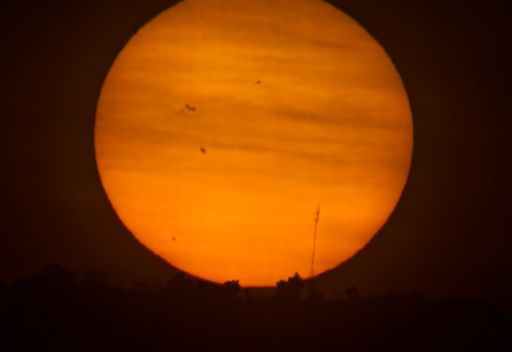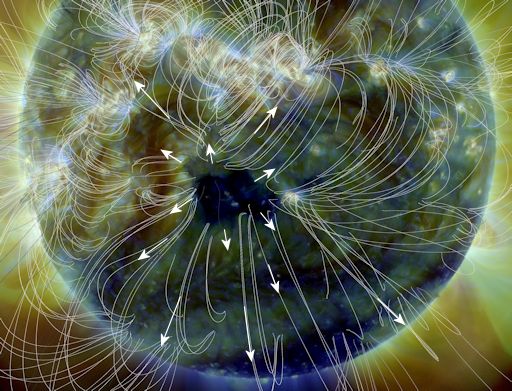Learn to photograph Northern Lights like a pro. Sign up for Peter Rosen's Aurora Photo Courses in Abisko National Park. | | |
INCOMING CME, STORMS POSSIBLE ON EARTH DAY: Yesterday, April 18th, a magnetic filament attached to sunspot group AR2321 erupted, producing a C5-class solar flare. A movie from NASA's Solar Dynamics Observatory shows the filament splitting the sun's atmosphere as it hurtles away from the blast site:

Part of the escaping filament formed the core of a faint CME, which is now heading almost directly for Earth. The cloud should reach our planet during the late hours of April 21st. In combination with a solar wind stream already en route, the impact could spark geomagnetic storms around the poles on April 22nd, Earth Day.
This is a minor CME launched by a minor C-class flare, so it is natural to expect only minor storms when the CME arrives. Indeed, that is probably what will happen. It is notable, however, that the intense geomagnetic storm of March 17, 2015, was triggered by a C-flare/CME combo only a little more intense than this one. The "St. Patrick's Day Storm" reminds us that any CME impact can produce a significant disturbance. Auroras for Earth Day, anyone? Stay tuned. Aurora alerts: text, voice.
Realtime Aurora Photo Gallery
SUNSPOT SUNRISE: The sun is peppered with so many spots, observers are beginning to notice them at sunrise--no filters required. Jett Aguilar "spotted" the dark cores this morning when the sun came up over Quezon City, the Philippines:

"At sunrise on April 19th I took an image of the sunspot-spotted sun rising over the Sierra Madre mountains of Luzon," he says. "I used an unfiltered Canon 300 mm f/4 lens with a 2x Canon extender on a Canon 7D DSLR. Exposure was 1/2000 sec at f/45, ISO 100."
Photographers should take note of these settings. Most of the sunspots pictured above will remain visible for another 5 to 7 days, providing daily photo-ops at sunrise and sunset. Flares are likely, too. The largest sunspots in the image (AR2321 and AR2124) have 'beta-gamma' magnetic fields that harbor energy for M-class explosions. Solar flare alerts: text, voice
Warning: Even when the sun is dimmed by low-hanging clouds or haze, it can still damage your eyes. Sunlight magnified by unfiltered optics is dangerously bright. If you chose to photograph the low sun, as Aguilar did, use the camera's LCD screen for safe viewfinding. Never look into the eyepiece of an unfiltered camera or telescope when the sun is in the field of view.
Realtime Space Weather Photo Gallery
CORONAL HOLE: NASA's Solar Dynamics Observatory (SDO) is monitoring a hole in the sun's atmosphere--a "coronal hole." It is colored deep-blue in this extreme UV image of the sun taken by SDO on April 17th:

Coronal holes are places where the sun's magnetic field opens up and allows solar wind to escape. In the image, above, the sun's magnetic field is traced by white loops. Arrows show the flow of material out of the hole.
Holes in the sun's atmosphere are not unusual; they appear several times each month. A stream of solar wind flowing from this particular coronal hole will probably reach Earth on April 22--the same time as the CME discussed in the news item above. This means we could have auroras for Earth Day. Stay tuned. Aurora alerts: text, voice
Realtime Space Weather Photo Gallery
Realtime Eclipse Photo Gallery
Realtime Comet Photo Gallery
Every night, a network of NASA all-sky cameras scans the skies above the United States for meteoritic fireballs. Automated software maintained by NASA's Meteoroid Environment Office calculates their orbits, velocity, penetration depth in Earth's atmosphere and many other characteristics. Daily results are presented here on Spaceweather.com.
On Apr. 19, 2015, the network reported 11 fireballs.
(11 sporadics)

In this diagram of the inner solar system, all of the fireball orbits intersect at a single point--Earth. The orbits are color-coded by velocity, from slow (red) to fast (blue). [Larger image] [movies]
Potentially Hazardous Asteroids (
PHAs) are space rocks larger than approximately 100m that can come closer to Earth than 0.05 AU. None of the known PHAs is on a collision course with our planet, although astronomers are finding
new ones all the time.
On April 19, 2015 there were potentially hazardous asteroids.
Notes: LD means "Lunar Distance." 1 LD = 384,401 km, the distance between Earth and the Moon. 1 LD also equals 0.00256 AU. MAG is the visual magnitude of the asteroid on the date of closest approach. | | The official U.S. government space weather bureau |
| | The first place to look for information about sundogs, pillars, rainbows and related phenomena. |
| | Researchers call it a "Hubble for the sun." SDO is the most advanced solar observatory ever. |
| | 3D views of the sun from NASA's Solar and Terrestrial Relations Observatory |
| | Realtime and archival images of the Sun from SOHO. |
| | from the NOAA Space Environment Center |
| | the underlying science of space weather |

